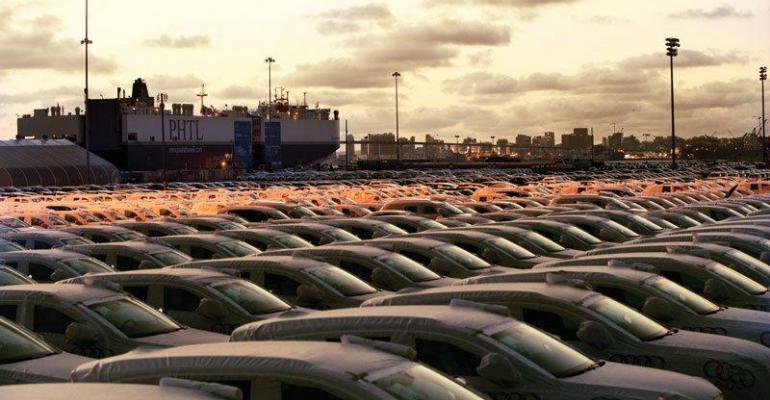BRUSSELS – Negotiations for a free-trade agreement between the European Union and the U.S., which started this month in Washington, could push the global auto industry toward a world vehicle-regulatory system for the first time, EU sources close to the negotiations say.
This would call for FTA negotiators to recognize both countries’ standards in car-safety tests. The EU’s automotive legislation is based on the United Nations World Forum for Harmonization of Vehicle Regulations, which also underpins Japanese and South Korean auto standards. U.S. standards largely are employed by Canada.
Thus, a truly global system would start to emerge for the first time.
If such negotiations were to conclude successfully, cars tested in the U.S. could be sold in the EU without additional safety testing and vice versa, according to a briefing note released by the European Commission’s directorate general for trade.
“There are many things that we can do in the regulatory framework without modifying the current legislation,” an EU official tells WardsAuto. “When it comes to cars, if we have equivalence between the U.S. and EU rules on the safety of cars, we can do that without modifying the legislation, as the legislation already foresees such equivalency.”
Another EU source with knowledge of the matter says the FTA negotiations between the two sides are not meant to change legislation dramatically on any shore of the Atlantic, but to find common sense and recognize each other’s standards.
“It’s about efficiency, streamlining where it’s possible and never at any costs for safety,” the source says.
The EC briefing note says through the free-trade deal, “the Commission would like regulators to formally recognize that important parts of our two regulatory systems are broadly the same in safety terms.”
The two sides have different but similar safety requirements when it comes to lights, door locks, brakes, steering, seats, seatbelts and electric windows, the document says. “Many of these could be formally recognized as providing the same level of safety.”
An EU position paper on technical barriers to trade in the EU-U.S. FTA negotiations goes further, saying it would like the vehicle-safety regulatory system to become a blueprint for other auto makers that may want to sign up in the future – for instance, those in China, Malaysia and India.
“It is preferable from a trade-facilitation perspective if the agreement is not closed or applied bilaterally only, but open to several partners who apply the international standard and wish to be part of the agreement,” the EC note says.
However, the EU auto makers’ group, the ACEA, does not dare to dream yet about greater mutual recognition on safety standards.
“The best that can be expected at the current stage of negotiations is that the respective parties agree on some degree of regulatory convergence,” an ACEA spokeswoman says. “This would enable manufacturers to design vehicles with greater certainty…(and) with fewer regulatory barriers.”
Matt Blunt, president of the American Automotive Policy Council, which represents the commom public policy interests of member companies Chrysler, Ford and General Motors, agrees the regulatory deal would not in itself immediately pull Japan, South Korea and others into a tight global vehicle- safety system. But he does predict it would prevent those and other jurisdictions from developing sharply different codes.
“It will stop global regulatory fragmentation,” he says.
The benefits would be enjoyed by European and American car buyers. “This is an opportunity to really open up the two marketplaces and allow consumers to have access to a much wider range of vehicles,” Blunt says, adding that an earlier EU impact study of the potential trade deal compared the cost of complying with differing EU and U.S. safety standards to a 26% tariff.
However, Europe and America both have “developed sophisticated rules with decades of history regulating vehicle safety and environmental impact,” he says. Americans feel comfortable renting cars in Europe, as do Europeans renting cars in the U.S.
“I think it makes sense to have a mutual recognition of top safety standards and do so in a way that maintains sovereignty,” Blunt says.
But Peter Cooke, professor of automotive management at England’s University of Buckingham, warns the EU could suffer from such a deal. Global auto makers might centralize parts-making, perhaps with two centers. One could be in North America and the other in Asia, with parts being shipped to Europe for assembly.
“Globally, there is an imbalance between supply and demand,” he says, “and one assumes rationalization in terms of production facilities and capacity in the short or medium term. (Once) regulations are harmonized, a global OEM would seek to produce in the lowest-cost manufacturing location, even if that is initially just components.”
“Next step, focus car production in North America and transfer jobs there,” Cooke says, adding Europe might gain from exporting higher-end finished vehicles directly to the U.S. without making technical adjustments, but (U.S. auto makers) might also benefit from shipping innovations, the widening of the Panama Canal and the increasing location of U.S. assembly plants near seaports.
– with Keith Nuthall in Ottawa, Canada





